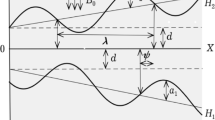Abstract
A procedure is proposed for solving problems of hydrodynamics and heat transfer in coiled tubes, such as loops with smooth pipe turns and helically coiled tubes. Application of a curvilinear (toroidal) coordinate system simplifies the solution to these problems. The differential equations of mass, momentum, and energy conservation were derived for a liquid metal using the tensor analysis provisions in a generalized coordinate system. The equations with additional terms added written in a cylindrical coordinate system are taken as a basis. These terms are necessary for changing over to a new (toroidal) coordinate system. The toroidal system also has an orthogonal basis where the coordinates are also expressed by the same triple of values. The difference from the cylindrical coordinate system is that the length of the third basis vector depends on the other two space coordinates and the radius of the curvature. The method of numerical simulation in the toroidal coordinate system considerable simplifies the geometric description of the problem, construction of the computational grid, formulation of the boundary conditions, and presentation of the results. The proposed approach enables us to model problems with different curvature radii within a single generalized form. The proposed procedure yielded velocity, pressure, and temperature fields for a liquid metal turbulent flow in a toroidal (coiled) tube. The parameter of the tube curvature radius was varied in the calculations. The parametric studies performed demonstrate the principal limits of the effect of the tube curvature on the liquid metal flow hydrodynamics and heat transfer.









Similar content being viewed by others
REFERENCES
V. M. Zorin, Nuclear Power Plants: Textbook (Mosk. Energ. Inst., Moscow, 2012) [in Russian].
A. V. Abramov, “Experimental safety substantiation of the BREST-OD-300 reactor unit in case of depressurization of heat exchange pipes,” in Proc. Int. Sci. and Tech. Conf. NIKIET-2014, Moscow, Russia, Oct. 7–10, 2014 (NIKIET, Moscow, 2014).
S. V. Vasil’ev and Yu. V. Kuz’minov, “Steam generator RU BREST-OD-300,” Project Direction “Breakthrough”: Proc. Conf., Kaluga Oblast, Russia, Apr. 3–4, 2015 (NIKIET, Moscow, 2015).
V. N. Leonov, Computational and Experimental Studies of the Processes Accompanying the “Interloop Leakage of the Steam Generator” Accident, and Recommendations for Schematic and Design Solutions for a Lead-Cooled Reactor Plant, Candidate’s Dissertation in Engineering (Nizhny Novgorod State Technical Univ., Nizhny Novgorod, 2012).
S. Sungnul, “Transformation of the Navier–Stokes equations in curvilinear coordinate systems with maple,” Global J. Pure Appl. Math. 12, 3315–3325 (2016).
A. I. Borisenko and I. E. Tarapov, Vector Analysis and the Beginnings of Tensor Calculus (Vysshaya Shkola, Moscow, 1966) [in Russian].
L. I. Sedov, Mechanics of Continuous Media (Lan’, St. Petersburg, 2004; World Sci., Singapore, 1997), Vol. 1.
D. A. Danielson, Vectors and Tensors in Engineering and Physics, 2nd ed. (CRC, Boca Raton, Fla., 2003). https://doi.org/10.1201/9780429502774
R. Aris, Vectors, Tensors, and the Basic Equations of Fluid Mechanics (Dover, New York, 1989).
Yu. N. Tokarev, “Heat transfer equations of swirling flows in polar-spiral coordinates,” Vestn. Mosk. Energ. Inst., No. 5, 115–117 (2004).
H. Ito, “Flow in curved pipes,” JSME Int. J. 30, 543–552 (1987). https://doi.org/10.1299/jsme1987.30.543
A. Chupin and R. Stepanov, “Full perturbation solution for the flow in a rotating torus,” Phys. Rev. 77, 057301 (2008). https://doi.org/10.1103/PhysRevE.77.057301
N. G. Razuvanov, “Solution of the problem of convective heat transfer in a helical coordinate system,” Vychisl. Mekh. Sploshnykh Sred 11, 175–184 (2018).
L. G. Loitsyanskii, Mechanics of Liquids and Gases (Drofa, Moscow, 2003; Elsevier, Kent, 2015).
V. I. Artemov, G. G. Yan’kov, V. E. Karpov, and M. V. Makarov, “Numerical simulation of processes of heat-and-mass transfer in items of heat and power equipment,” Therm. Eng. 47, 632–640 (2000).
V. G. Sviridov, N. G. Razuvanov, Yu. P. Ivochkin, Ya. I. Listratov, E. V. Sviridov., L. G. Genin, V. G. Zhilin, and I. A. Belyaev, “Liquid metal heat transfer investigations applied to Tokamak reactor,” in Proc. Int. Heat Transfer Conf. (IHTC14), Washington, DC, Aug. 8–13, 2010 (ASME, New York, 2010), Paper No. IHTC14-22369, pp. 287–294. https://doi.org/10.1115/IHTC14-22369
I. I. Poddubnyi and N. G. Razuvanov, “Investigation of hydrodynamics and heat transfer at liquid metal downflow in a rectangular duct in a coplanar magnetic field,” Therm. Eng. 63, 89–97 (2016). https://doi.org/10.1134/S0040601516020063
R. N. Lyon, “Liquid metal heat transfer coefficients,” Chem. Eng. Prog. 47, 75–79 (1951).
Funding
The work was financially supported by the Ministry of Science and Higher Education of the Russian Federation (State Assignment no. 075-01056-22-00).
Author information
Authors and Affiliations
Corresponding author
Additional information
Translated by T. Krasnoshchekova
Rights and permissions
About this article
Cite this article
Razuvanov, N.G., Belavina, E.A., Polyanskaya, O.N. et al. Solution to the Problem of Convective Heat Transfer in a Toroidal Channel Using a Curvilinear Coordinate System. Therm. Eng. 69, 585–595 (2022). https://doi.org/10.1134/S0040601522080079
Received:
Revised:
Accepted:
Published:
Issue Date:
DOI: https://doi.org/10.1134/S0040601522080079




